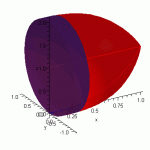Idealistic
Junior Member
- Joined
- Sep 7, 2007
- Messages
- 97
I have the function y = x[sup:3gbsot7d]3[/sup:3gbsot7d] where x is [0, 1], I have y = 1 where x is [0, 1], and the curve is rotated about y = 1. They want to know the area under y = x[sup:3gbsot7d]3[/sup:3gbsot7d] using the washer method and cylindrical shells.
the formula for cylindrical shells is, integral of 2pi(y)xdx,
but because the shells have to be parallel to the axis of rotaion, I have to express x in terms of y.
The function becomes x = y[sup:3gbsot7d]1/3[/sup:3gbsot7d].
I have:
integral of 2pi(1)ydy - 2pi(y[sup:3gbsot7d]1/3[/sup:3gbsot7d])ydy (from y is [0, 1])- this represent the total area subtract the area given from x = y[sup:3gbsot7d]1/3[/sup:3gbsot7d] where y is [0, 1] which gives the area under y = x[sup:3gbsot7d]1/3[/sup:3gbsot7d].
piy[sup:3gbsot7d]2[/sup:3gbsot7d] - 6/7(piy[sup:3gbsot7d]7/3[/sup:3gbsot7d]) from y is [0, 1]
pi - 6pi/7 = pi/7
But when I do the washer method, my washers are perpendicular to the axis of rotation (y = 1) so my equation is:
integral of pi(1)dx - pi(1 - x[sup:3gbsot7d]3[/sup:3gbsot7d])[sup:3gbsot7d]2[/sup:3gbsot7d]dx (from x is [0, 1]) - comes from (integral of piy[sup:3gbsot7d]2[/sup:3gbsot7d]dx) but my radius is going to be 1 minus x[sup:3gbsot7d]3[/sup:3gbsot7d] which is the vertical distance from y = 1 to y = x[sup:3gbsot7d]3[/sup:3gbsot7d].
pix - (pix - (1/2)pix[sup:3gbsot7d]4[/sup:3gbsot7d] + (1/7)pix[sup:3gbsot7d]7[/sup:3gbsot7d]) from x is [0, 1]
pi/2 - pi/7 = 5pi/14
The problem is i'm not getting the same answer for both.
the formula for cylindrical shells is, integral of 2pi(y)xdx,
but because the shells have to be parallel to the axis of rotaion, I have to express x in terms of y.
The function becomes x = y[sup:3gbsot7d]1/3[/sup:3gbsot7d].
I have:
integral of 2pi(1)ydy - 2pi(y[sup:3gbsot7d]1/3[/sup:3gbsot7d])ydy (from y is [0, 1])- this represent the total area subtract the area given from x = y[sup:3gbsot7d]1/3[/sup:3gbsot7d] where y is [0, 1] which gives the area under y = x[sup:3gbsot7d]1/3[/sup:3gbsot7d].
piy[sup:3gbsot7d]2[/sup:3gbsot7d] - 6/7(piy[sup:3gbsot7d]7/3[/sup:3gbsot7d]) from y is [0, 1]
pi - 6pi/7 = pi/7
But when I do the washer method, my washers are perpendicular to the axis of rotation (y = 1) so my equation is:
integral of pi(1)dx - pi(1 - x[sup:3gbsot7d]3[/sup:3gbsot7d])[sup:3gbsot7d]2[/sup:3gbsot7d]dx (from x is [0, 1]) - comes from (integral of piy[sup:3gbsot7d]2[/sup:3gbsot7d]dx) but my radius is going to be 1 minus x[sup:3gbsot7d]3[/sup:3gbsot7d] which is the vertical distance from y = 1 to y = x[sup:3gbsot7d]3[/sup:3gbsot7d].
pix - (pix - (1/2)pix[sup:3gbsot7d]4[/sup:3gbsot7d] + (1/7)pix[sup:3gbsot7d]7[/sup:3gbsot7d]) from x is [0, 1]
pi/2 - pi/7 = 5pi/14
The problem is i'm not getting the same answer for both.

